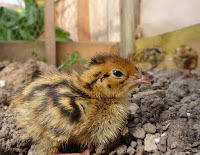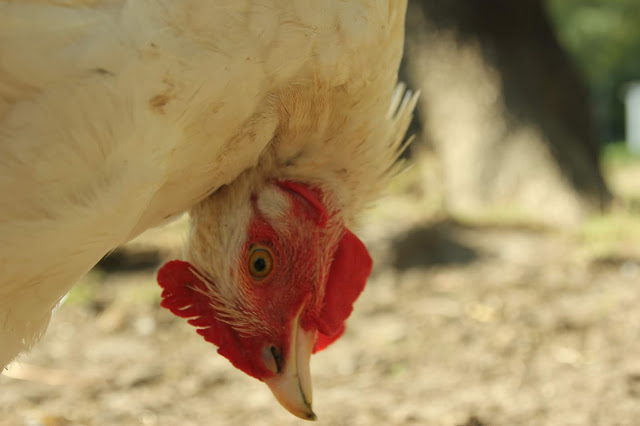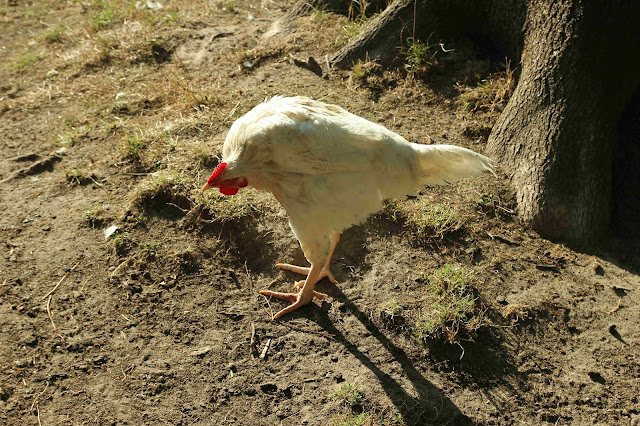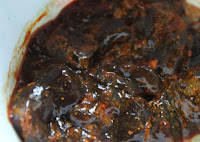This is a departure from my usual format, in that this was an
open-ended treatment with no definite conclusion because I just had two weeks with this very courageous
bird. His ability to thrive with such a difficult condition bore
witness to the amazing resilience and determination of 'chickens' in
particular and made me ever more aware of why I find them fascinating. I
just hope that I did him some good and I leave it for you to judge, as at the end of this two part article I enclose the film I made of the whole process.
I have actually had success with wry neck treatment before but in a duckling and obviously thus of a much younger age than Mr Upside Down. I was also able to spend more time with the former and thus continue the treatment to its cure. A very obvious trigger for this condition, as I'd observed with the duckling who was the 'runt of the litter', was stress. Stress was particularly conspicuous in the case of the cockerel, who was initially picked upon by the other male birds....

...but as you can see evidenced below, very much accepted by the hens. This is not surprising as he is a very gentle bird and very much the antithesis of his swaggering and posturing confreres, who are just of an age to be very annoying to the females who shun them.
Wry Neck aka Torticollis - Symptoms & Causes
Wry neck or to give it is scientific name Torticollis is a condition where, as the appellation suggests, the bird is unable to control its neck, which goes into spasm and twists, usually bending the head in an upside down position, often descending to floor level. The spasms are caused by severe pain and the neck bends away from that painful sensation causing it to twist. Obviously this condition can be fatal, purely because the bird can find itself unable to eat or drink. However, such was Mr Upside Down's strength of mind and resolution that he had even developed a strategy for feeding himself upside down! On several occasions I saw him consuming grain and sifting through the earth with his head curled backwards below his breast.
The exact causes of wry neck are not really known but there are several indications as to why it occurs and it is this perceived wisdom which can be used to inform us how to improve and even cure the condition. Among the triggers for torticollis, both as unique sources or as combined factors, are:
- trauma to the head and/or neck
- extreme stress, such as instigated by predator attack or bullying
- difficulty at hatch caused by poor positioning in the egg
- toxins which disrupt nervous system function and/or cause malabsorption of essential nutrients
- lack or deprivation of essential nutrients
 This last trigger is of great interest to me as it is the one I have used to cure the condition before. There are, for example, 13 Vitamins which are crucial in a poultry diet, a deficiency in even one can induce neurological illness and thus problems with locomotion, paralysis and eventually cell die-off. In the next part of this article I will detail them and other trace elements and list the foods and sources I used to obtain them for Mr Upside Down.
This last trigger is of great interest to me as it is the one I have used to cure the condition before. There are, for example, 13 Vitamins which are crucial in a poultry diet, a deficiency in even one can induce neurological illness and thus problems with locomotion, paralysis and eventually cell die-off. In the next part of this article I will detail them and other trace elements and list the foods and sources I used to obtain them for Mr Upside Down.Initial Observations - Stress & Wry Neck - Emotional Support
I'm a great believer in the havoc and incidentally and conversely, the benefit stress can engender within the immune system and in particular when the body is in a state of deficiency. In humans, stress at times of illness can make or break them and birds in my experience are no different. I always remember being told of the creator of a particularly large and successful fabric company, who suffered a stroke and was completely paralysed. Several months after his stroke, a friend visited him in hospital and inadvertently let slip that the company was heading into bankruptcy, that same afternoon the patient began to move his big toe and went on to make a full recovery and to save his company.
 |
| BUILDING CONFIDENCE |
Continuing to Boost Confidence & Improve Flock Status
Stress is known to cause a depletion of and/or create a barrier to, the uptake of many essential vitamins and minerals which are involved with normal growth, motor function and nervous system optimisation. Therefore, it is really important to rectify this situation at the outset otherwise you are wasting your time and good nutrition. In a normal situation I would of course remove the bird to a different location away from any potential stressors and have him in a group just with the females. However, as this was not possible I made sure I spent a good amount of time with him every day and this did actually seem to give him status and thus confidence. I think this was reflected both in the way he began to hold himself physically as you will see from the end of the film and the fact that he stopped competing for food. This because obviously being hand-fed it was no longer necessary for him to fight for essential nutrition.In Part Two I'll detail the nutritional support and the age-related problems hampering the usually speedy recovery time.
Thanks for dropping by and do feel free to share experiences or ask for further information in the comment section. If you have enjoyed this piece and found it
useful think about sharing it with your family and friends, on social media and also maybe about joining this blog
and/or subscribing to my Youtube channel or even supporting us on
Patreon or
It all helps to keep me going!Until next time, all the very best from Normandie! Sue
© 2020 Sue Cross
RELATED ARTICLES
Wry Neck/Torticollis Part 2 Detailed Nutritional Treatment
Thus having establishing a more important position within the flock by
giving Mr Upside Down some time out and the additional status of being
hand-fed, I will now detail the diet I put him upon to try...read more
 Identification of riboflavin deficiency in purchased quail and hatching eggs
Identification of riboflavin deficiency in purchased quail and hatching eggs
Quail have a high basal metabolic rate and as such their problems with nutrition are dramatically and rapidly revealed...read more
 Cure curled toe paralysis (riboflavin deficiency)
Cure curled toe paralysis (riboflavin deficiency)
For my 'field study', I am using the example of quail chicks, from
non-organic purchased hatching eggs because this is the area in which,
sadly I have a great deal of experience ..read more









No comments:
Post a Comment